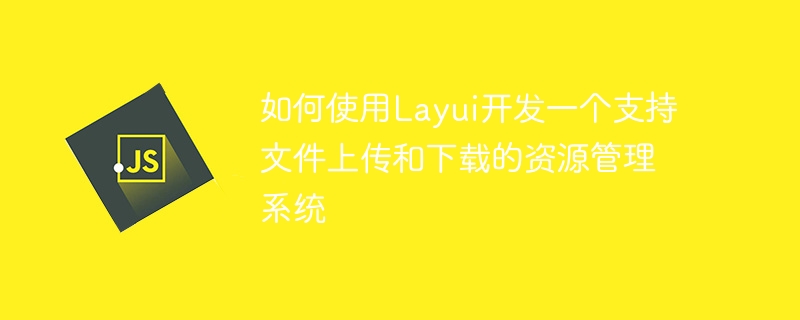

How to use Layui to develop a resource management system that supports file upload and download
Introduction:
With the development of the Internet, the management of data resources has become a an important task. Whether it is document management within an enterprise or personal file storage, an efficient and easy-to-use resource management system is required. Layui is a lightweight front-end framework with a simple and clear design and a rich component library, which is very suitable for the development of resource management systems. This article will introduce how to use Layui to develop a resource management system that supports file upload and download, and give specific code examples.
1. Set up a development environment
Before starting development, we need to set up a suitable development environment. First make sure you have Node.js and npm (Node package manager) installed. Then, install the Layui command line tool through npm:
npm install -g layui
So we can use the Layui command to create a new Layui project:
layui new resource-manage
This command will create a new Layui project named It is the folder of resource-manage and automatically initializes a Layui project.
2. Page layout and module design
Next, we need to design the page layout and basic modules of the resource management system. We can use Layui's grid system to flexibly adjust the page layout. Place a navigation bar at the top of the page for searching and uploading files; the left sidebar is used to display file categories and navigate files; the right side is for displaying file lists and file details.
Before implementing the page layout, we need to introduce the necessary Layui components and styles and open the index.html file in the root directory of the project. First, introduce Layui's style file:
<link rel="stylesheet" href="../layui/css/layui.css">
Then, introduce Layui's JavaScript file:
<script src="../layui/layui.js"></script>
Next, add a div container with Layui characteristics in the body tag:
<body>
<div class="layui-layout layui-layout-admin">
<!-- 页面布局代码 -->
</div>
</body>3. Implement file upload and download functions
Layui provides a convenient file upload component layui-upload, which we can use to implement File upload function. First, add an upload button in HTML:
<div class="layui-btn layui-btn-normal" id="upload-btn">上传文件</div>
Then, we need to listen to the click event of the upload button in JavaScript and use layui-upload to process the file upload:
<script>
layui.use(['upload'], function() {
var upload = layui.upload;
// 文件上传事件监听
upload.render({
elem: '#upload-btn', // 绑定上传按钮的 id
url: '/upload', // 文件上传的接口地址
done: function(res) { // 上传成功的回调函数
console.log(res);
// 文件上传成功的处理逻辑
},
error: function() { // 上传出错的回调函数
// 文件上传出错的处理逻辑
}
});
});
</script>Layui does not provide a direct file download component, but we can implement the file download function by writing JavaScript. First, we need to add a download link in the HTML:
<a href="/download/file.pdf" download>下载文件</a>
Then, we can click the download link to trigger the download of the file.
4. Improve the resource management system functions
In the resource management system, we need to display the file list to the user. We can use Layui's Table component to achieve this function. First, add a table container in HTML:
<table class="layui-table" lay-filter="file-table">
<thead>
<tr>
<th>文件名</th>
<th>大小</th>
<th>上传时间</th>
<th>操作</th>
</tr>
</thead>
<tbody>
<!-- 文件列表数据 -->
</tbody>
</table>Then, use the layui.table.render() function in JavaScript to render the table and set the data source:
<script>
layui.use(['table'], function() {
var table = layui.table;
// 表格渲染
table.render({
elem: '#file-table', // 绑定表格容器的 id
url: '/api/files', // 表格数据接口地址
cols: [[
{field: 'name', title: '文件名'},
{field: 'size', title: '大小'},
{field: 'time', title: '上传时间'},
{fixed: 'right', title:'操作', toolbar: '#file-operation'}
]]
});
});
</script>We add a delete button in the operation column of the file list to delete files. We can use Layui's toolbar method to achieve this function.
First, add a template in HTML and define the delete button:
<script type="text/html" id="file-operation"> <a class="layui-btn layui-btn-danger layui-btn-xs" lay-event="delete">删除</a> </script>
Then, listen to the toolbar click event of the table in JavaScript and perform the corresponding operation according to the event type:
<script>
table.on('tool(file-table)', function(obj){
if(obj.event === 'delete'){
// 删除文件的处理逻辑
}
});
</script>5. Summary
This article introduces how to use Layui to develop a resource management system that supports file upload and download. By introducing Layui's style files and JavaScript files, we implemented page layout and module design. The file upload function is implemented by using layui-upload, and the file download function is implemented by writing JavaScript. Finally, we use the layui.table component and layui.form component to improve the functions of the resource management system.
Through the study of this article, I believe that readers have mastered how to use Layui to develop resource management systems and have certain front-end development capabilities. Next, readers can further develop and optimize the code examples according to their own needs to achieve a richer and more efficient resource management system.
The above is the detailed content of How to use Layui to develop a resource management system that supports file upload and download. For more information, please follow other related articles on the PHP Chinese website!